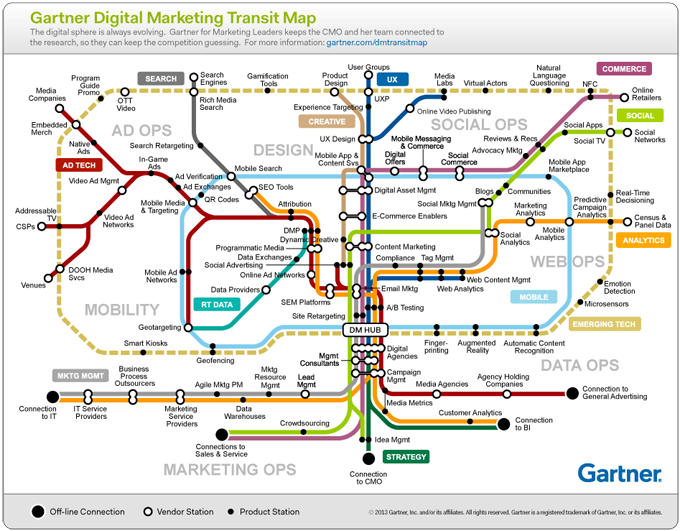Plotting a digital marketing strategy can prompt even some of the savviest B2B marketers to ask for directions. Gartner recently unveiled its digital marketing transit map to provide a framework for marketers to develop a strategy, improve operations and plan initiatives.
One of the hurdles of marketing technology is that most organizations have acquired much of their technologies individually, so there is no plan in place regarding how they will connect, according to Andrew Frank, VP and Distinguished Analyst at Gartner, in an interview with Demand Gen Report. He said this challenge led to the creation of the map, which was developed over the course of the past year, to help facilitate communication between marketing and IT.
“Marketing and IT sometimes talk past one another,” Frank said. “A tool like the transit map can help to center the conversation on practical and pragmatic issues that impact both marketing and IT. We’ve tried to present a comprehensive landscape of marketing technologies that will enable organizations to see every kind of service and technology that is available and how they relate to each other. This will allow organizations to identify the best sources for their needs and acquire systems that work well together.”
While technology was once focused on automating internal processes, the goal of technology today is to enable companies to be more customer-centric, Frank explained. “That isn’t just for B2C marketers, but for B2B marketers, as well. It really means establishing a consistent digital identity across all channels and situations.”
Content Marketing A Main Track For B2B Marketers
For B2B marketers on a customer-centric route, Frank said that the “Content Marketing” line on the map should play a prominent role as they build their systems. “The map shows content marketing connecting with commerce, and that is really where it is headed for B2B marketers. They are all looking for ways to build the pipeline with content. This is definitely an area with potential for expansion.”
“User Experience” is another section of the map that should be a particular focus for B2B marketers, Frank noted. “It is not something that B2B marketers have paid as much attention to as their B2C counterparts, but they are beginning to recognize the value of the user experience. Moving forward, B2B organizations will be focusing on strategies such as ad retargeting and seeking out look-alike prospects.”
{loadposition SPIAA}The “Dynamic Creative” stop is going to be pivotal for B2B marketers as they look to provide more personalized content, Frank said. “In some ways it is harder for B2B marketers to treat their customers as individuals than B2C marketers. But dynamic creative optimization is an important part of this map for B2B marketers. To give you some examples, they want to serve up different content to prospects who are interacting with them for the first time versus those who are familiar with their products and servers. They may also want to serve up different content to different customers based on where they are in the renewal cycle. Dynamic creative optimization helps them do that.”
“Social” is a neighborhood on the map that B2B marketers will be traveling to more frequently, according to Frank. “Social is intersecting with everything on the map and B2B marketers can’t ignore it.”
Click here for an interactive version of the map.







